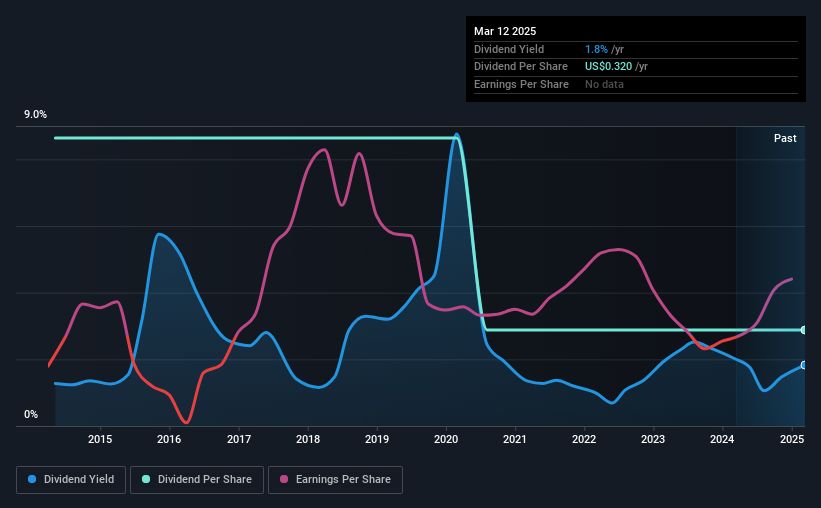Valhi (NYSE:VHI) Could Be A Buy For Its Upcoming Dividend
Readers hoping to buy Valhi, Inc. (NYSE:VHI) for its dividend will need to make their move shortly, as the stock is about to trade ex-dividend. The ex-dividend date is usually set to be one business day before the record date, which is the cut-off date on which you must be present on the company's books as a shareholder in order to receive the dividend. The ex-dividend date is important as the process of settlement involves a full business day. So if you miss that date, you would not show up on the company's books on the record date. This means that investors who purchase Valhi's shares on or after the 17th of March will not receive the dividend, which will be paid on the 28th of March.
The company's next dividend payment will be US$0.08 per share. Last year, in total, the company distributed US$0.32 to shareholders. Last year's total dividend payments show that Valhi has a trailing yield of 1.8% on the current share price of US$17.49. We love seeing companies pay a dividend, but it's also important to be sure that laying the golden eggs isn't going to kill our golden goose! As a result, readers should always check whether Valhi has been able to grow its dividends, or if the dividend might be cut.
See our latest analysis for Valhi
Dividends are typically paid out of company income, so if a company pays out more than it earned, its dividend is usually at a higher risk of being cut. Valhi is paying out just 8.4% of its profit after tax, which is comfortably low and leaves plenty of breathing room in the case of adverse events. A useful secondary check can be to evaluate whether Valhi generated enough free cash flow to afford its dividend. Dividends consumed 69% of the company's free cash flow last year, which is within a normal range for most dividend-paying organisations.
It's encouraging to see that the dividend is covered by both profit and cash flow. This generally suggests the dividend is sustainable, as long as earnings don't drop precipitously.
Click here to see how much of its profit Valhi paid out over the last 12 months.

Have Earnings And Dividends Been Growing?
Businesses with strong growth prospects usually make the best dividend payers, because it's easier to grow dividends when earnings per share are improving. If earnings decline and the company is forced to cut its dividend, investors could watch the value of their investment go up in smoke. Fortunately for readers, Valhi's earnings per share have been growing at 17% a year for the past five years. Valhi is paying out a bit over half its earnings, which suggests the company is striking a balance between reinvesting in growth, and paying dividends. This is a reasonable combination that could hint at some further dividend increases in the future.
Another key way to measure a company's dividend prospects is by measuring its historical rate of dividend growth. Valhi's dividend payments per share have declined at 10% per year on average over the past 10 years, which is uninspiring. Valhi is a rare case where dividends have been decreasing at the same time as earnings per share have been improving. It's unusual to see, and could point to unstable conditions in the core business, or more rarely an intensified focus on reinvesting profits.
Final Takeaway
Is Valhi worth buying for its dividend? Earnings per share have grown at a nice rate in recent times and over the last year, Valhi paid out less than half its earnings and a bit over half its free cash flow. Overall we think this is an attractive combination and worthy of further research.
While it's tempting to invest in Valhi for the dividends alone, you should always be mindful of the risks involved. Every company has risks, and we've spotted 3 warning signs for Valhi (of which 1 is a bit concerning!) you should know about.
Generally, we wouldn't recommend just buying the first dividend stock you see. Here's a curated list of interesting stocks that are strong dividend payers.
Have feedback on this article? Concerned about the content? Get in touch with us directly. Alternatively, email editorial-team (at) simplywallst.com.
This article by Simply Wall St is general in nature. We provide commentary based on historical data and analyst forecasts only using an unbiased methodology and our articles are not intended to be financial advice. It does not constitute a recommendation to buy or sell any stock, and does not take account of your objectives, or your financial situation. We aim to bring you long-term focused analysis driven by fundamental data. Note that our analysis may not factor in the latest price-sensitive company announcements or qualitative material. Simply Wall St has no position in any stocks mentioned.
 Wall Street Journal
Wall Street Journal